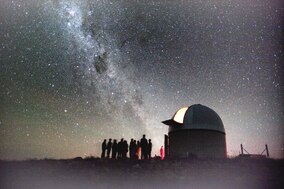Aoraki Mackenzie International Dark Sky Reserve
| Aoraki Mackenzie International Dark Sky Reserve | |
|---|---|
 Mount John Observatory | |
| Location | Aoraki / Mount Cook, New Zealand |
| Nearest town | Twizel |
| Area | 4,367 km2 (1,686 sq mi) |
| Designated | 2012 |
| Governing body | International Dark-Sky Association |
| Website | www |
The Aoraki Mackenzie International Dark Sky Reserve is an area of 4,367 km2 (1,686 sq mi) that was designated as an International Dark Sky Reserve by the International Dark-Sky Association in June 2012. The reserve is located in the Mackenzie District in the South Island of New Zealand. At the time of the designation in 2012, the reserve was the largest in the world, and the only reserve of its type in the Southern Hemisphere.[1][2]
The area covered by the reserve includes the Aoraki / Mount Cook National Park and the Mackenzie Basin, Lake Pukaki and Lake Tekapo. The main settlements within the reserve are Mount Cook Village, Twizel, and Lake Tekapo (town).[3][4]
The night sky brightness in the reserve ranks at a level 2 on the nine-level Bortle Dark-Sky Scale, representing a truly dark site with high astronomical observability of celestial objects.[5][6] The low level of light pollution in the area of the reserve has been supported by a lighting by-law that was included in the Mackenzie District Plan in 1981.[7]
The Mount John University Observatory is located in the reserve, and is the main astronomical research observatory in New Zealand.[8] There is also a star-gazing tourism venture, Dark Sky Project, operating in the Lake Tekapo township.[9]
References
- ^ "New Zealand's Aoraki Mackenzie Named World's Largest International Dark Sky Reserve" (PDF). International Dark Sky Association. 9 June 2012. Archived (PDF) from the original on 16 February 2021. Retrieved 28 December 2021.
- ^ Gibson, Jacqui (3 August 2021). "'There's drama Everywhere': Dark Sky adventure at Takapō". New Zealand Herald. Archived from the original on 6 October 2021. Retrieved 6 October 2021.
- ^ "The Aoraki Mackenzie International Dark Sky Reserve". Aoraki Mackenzie International Dark Sky Reserve. Retrieved 4 February 2024.
- ^ "Aoraki Mackenzie (New Zealand)". International Dark Sky Association. Archived from the original on 8 May 2021. Retrieved 8 May 2021.
- ^ An Application to the International Dark-Sky Association for a Starlight Reserve in the Aoraki/Mt Cook National Park and the Mackenzie Basin of the central South Island of New Zealand (PDF). Mackenzie District Council, University of Canterbury, Royal Astronomical Society of New Zealand, Department of Conservation. 27 January 2012. p. 25. Archived from the original (PDF) on 4 February 2024.
- ^ Strong, Rebecca (21 May 2023). "Stunning photos of the night sky in one of the darkest places on Earth will make you want to visit New Zealand ASAP". Business Insider. Retrieved 4 February 2024.
- ^ Downes, Siobhan (6 January 2017). "New Zealand's greatest gifts: Aoraki Mackenzie International Dark Sky Reserve". Stuff. Retrieved 4 February 2024.
- ^ Rae, Sally (4 August 2009). "A tranquil trip to Lake Tekapo". Otago Daily Times. Retrieved 4 August 2009.
- ^ MacDuff, Keiller (1 December 2021). "Takapō/Tekapo's Dark Sky Project wins top tourism award". Stuff. Retrieved 28 December 2021.
External links
- Aoraki Mackenzie International Dark Sky Reserve, podcast dated 8 August 2015 at RNZ
- Dark Sky Project
- Lighting and the Aoraki Dark Sky Reserve at Mackenzie District Council
- Stargazing & Astrophotography at Mackenzie Region
- Articles with short description
- Short description matches Wikidata
- Use dmy dates from February 2024
- Use New Zealand English from February 2024
- All Wikipedia articles written in New Zealand English
- 2012 establishments in New Zealand
- Aoraki Mackenzie International Dark Sky Reserve
- Aoraki / Mount Cook National Park
- Astronomy in New Zealand
- International Dark Sky Reserves
- Mackenzie District